

Gary Stark interview
By Scott Stilphen
(2009)

Q: What is your educational background?
Gary Stark: I earned a BS in General Engineering and a Mathematics Minor, from San Jose State University, CA.
Q: What inspired you to go into game design? Were there any programmers or games that inspired you?
Gary Stark: Prior to Atari, I created my own video games on a Z80 Microcomputer I got from my father who worked at Zilog at the time. So it seemed like a fun occupation, but honestly, I didnít really give it that much thought. It just sorta happened.
Q: What was your first job after you graduated?
Gary Stark: I applied to Atari right out of college, in the Consumer Division (Steve Wrightís group), working on games in conjunction with Sesame Street.
Q: How did the opportunity at Atari come about?
Gary Stark: I applied; they hired me. It all happened very fast and without much planning. Steve Wright hired me and was my manager. His division took on the educational games with Sesame Street.
Q: What was the development process like?
Gary Stark: Absolutely nothing like school. No complex mathematics, instead learning to master in 6502 assembly to the point of knowing how many machine cycles every instruction took to execute, turning the electron gun on & off as it scanned across the screen every 76 machine cycles. Very different than ďschoolĒ programming where we learned with punch cards, etc.
Q: What were the hours in your department? Was your schedule fixed (i.e. 9 to 5) or could you basically come and go as you pleased?
Gary Stark: : I donít recall. I suspect it was a fair amount of overtime, but I enjoyed the work so it didnít really matter.
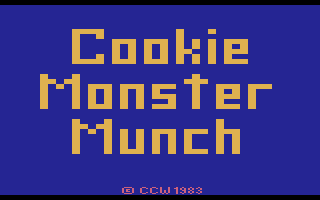
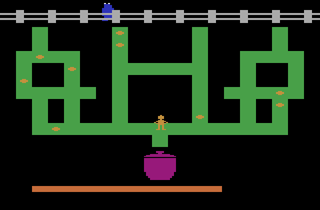
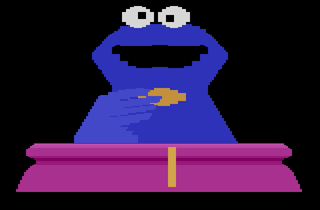
Atari VCS/2600 Cookie Monster Munch
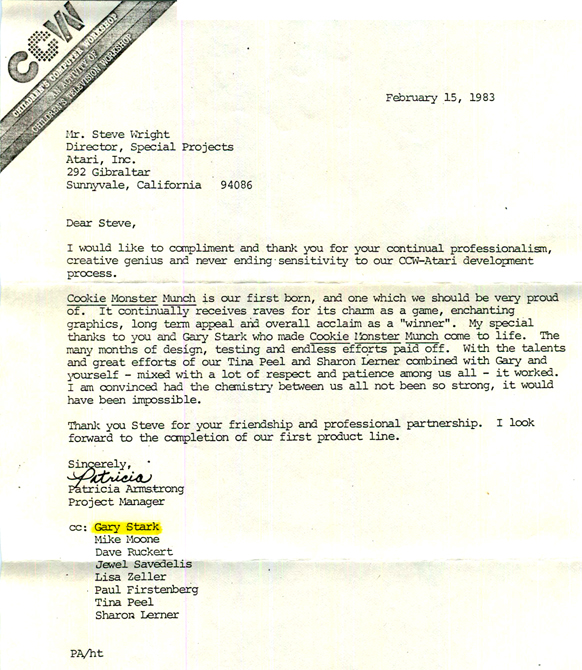
Letter of commendation from Patrician Armstrong, Project Manager, to
Steve Wright, Director of Special Projects.
Q: Can you talk a bit about the games you worked on during your time at Atari?
Gary Stark: Cookie Monster Munch was basically handed to me to implement from Steve Wright. Ultimately, Steve was very helpful teaching me how to program the VCS console, but all the programming, graphics, and audio was entirely mine. That was before game development required large teams of specialists. From the above letter, I think Sharon Lerner and Tina Peel worked for Sesame Street.
Dune was up to us, but didnít go anywhere. The Last Starfighter was our design (Bruce Poehlman & myself).
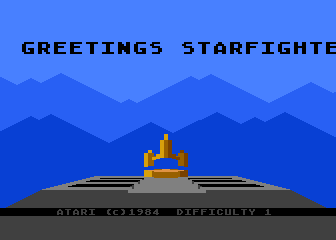
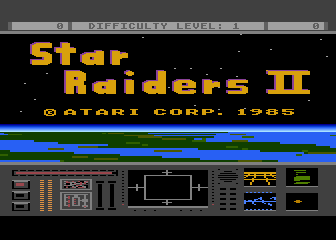
Atari 400/800 The Last Starfighter (LEFT); Star Raiders II (RIGHT)
Q: Regarding The Last Starfighter, were you involved with doing a VCS/2600 as well, or just the 8-bit (400/800/5200) version?
Gary Stark: I was only involved in the 800/5200 version. I donít recall the 2600 version.
Q: Any involvement with the Atari computer version of Star Raiders II (which is basically the same as Last Starfighter with some graphics changes)?
Gary Stark: Yes, Bruce Poehlman and I did it on contract. Totally ours.
Q: Were the titles you worked on assigned, or chosen by yourself?
Gary Stark: Cookie Monster Munch was assigned, but the rest I chose.
Q: Did you work with any graphics or sound artists? If so, do you recall who helped with what? I know Preston Stuart was involved with a few of the CCW games for the VCSÖ
Gary Stark: : For the 2600 stuff, we did our own music (if you can call it that). I also did my own graphics (using graph paper to plot it out). I also did the graphics for Star Raiders II.
Q: Do you recall anything about the VCS CCW titles Counting with the Count/Countís Castle, or Honker Bonker?
Gary Stark: NoÖ too long ago.
Q: Were there any plans to make CCW games for the 5200?
Gary Stark: I donít recall any such plans, but that doesnít mean anything. I certainly wasnít involved in any such efforts.
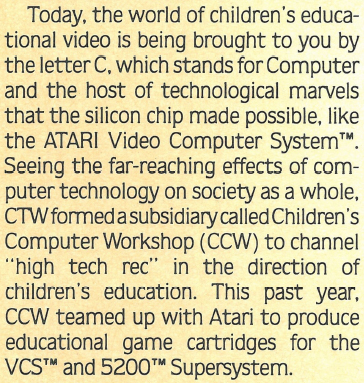
Article from the V2N2 issue of Atari Life
newsletter (pg. 1) mentioning CCW games planned
for the 5200.
At least 3 games were planned: Astro-Grover, Big Bird
Hide & Seek, and Muppet-Go-Round (LINK). A 5200 Kid's controller
prototype also exists (LINK).
Q: Were there any other games that you worked on besides those mentioned, or other game companies besides Atari?
Gary Stark: I also made a music composition cartridge to help me develop music for my 2600 game, but of course that wasnít a production product. I also recall obtaining the code for 2600 Space Invaders and replacing the graphics with the letters in a couple of friendís names, just for fun.
I did games beyond Atari, and also
(later) arcade games for Atari. I was with Atari when it was taken over by
the Tramielís. By then the chaos of the changes had prompted me to find
another job, so I left at that point.
I also worked at Bally/Sente twice, and was laid off both times (I didnít learn
my lesson the first time). The second time was when they let everyone go;
I only worked on tools then (a graphic editor).
Atari Games was about a 10 year stint where I did all the games officially
credited to me. Ed Rotberg hired me into coin-op since he had
worked with me before (Bally/Sente). I helped a tiny bit with Hard
Drivin' (wrote code to interpret MIDI music) - barely enough to warrant my
name on the credits.
Konami was my last and worst game company. They were run (very poorly) by
Japanese management from afar. I finally quit in frustration after only 6
months.
Q: Occasionally, programmers would put little ďEaster eggsĒ in some of their games that would reveal their name, or a message. I know that the 5200 version of The Last Starfighter contains a few - one being the ship from Star Trek makes an appearance (although nobody has yet to figure out how to trigger its appearance). Are there Easter eggs in any of your other titles? Do you recall any fellow co-workers that did?
Gary Stark: I wanted to sneak in secret mazes that spelled my initials, etc as Easter eggs, but Steve Wright wasnít too keen on that. This was a time when they didnít even include the gameís credits. Everything after Cookie Monster Munch had Easter eggs, but none that people donít already know about, or at least none that I remember as still hidden.
Q: Iím surprised with your comments about Steve Wright not wanting you to include any Easter eggs in Cookie Monster, since Wright himself publicly claimed in late 1981 that, from then on, Easter eggs were to be intentionally planted in subsequent games (in response to the positive reaction about finding them from players).
Gary Stark: That may be, but I assure youÖ he was NOT interested in Easter eggs in my game when I brought up the issue. Could be he was in a hurry to get the game out or something (although mine was the first one completed as I recall).
Q: If you had a chance to redo any of your games, what would you change (if anything)?
Gary Stark: I would do T-Mek as I first envisioned it (as a strategy game). It was created during a time when dedicated ďgame designersĒ were being added to the team. While I respect Matthew Ford as a game designer, he didnít make T-Mek a game I wanted to play. Coulda..woulda..shouldaÖ
Q: I would love to have seen your version, although I liked the coin-op. I saw it as a souped-up Battlezone, or even a modern version of Atariís (Key Games) Tank game.
Gary Stark: It was a strategy-oriented game. Basically you had to find ways to attack enemy ships of differing capabilities. Although it only used a sprite-based hardware (not polygon), it looked very 3-D. This was developed just as all the graphic development was moving towards rendering instead of artistic or, in our case, physical models that we had created and then filmed & digitized. The physical models were incredible, and were made by a guy in Hollywood named John Ferrari.
Q: Did you ever attend any industry shows, such as CES, Comdex, or Toy Fair?
Gary Stark: I attended a few CES shows, but not much else.
Q: Since Konami, have you stayed within the field of game design?
Gary Stark: Nope. Iím currently doing IT and database design for a construction company. Iím also constantly change the world through my personal websites such as www.UnitedDemocraticNations.org and www.PRTProject.com.
Q: Which of your titles are your favorite, and what types of games in general?
Gary Stark: I donít play gamesÖ Iíve never been much of a player. I was more interested in studying how others played.
Q: Do you still own any of your games for these systems, either as a keepsake, or to show friends or family
Gary Stark: I have boxed copies of the games I did, but not the consoles to play them.
Q: Have you stayed in touch with any of your former Atari co-workers?
Gary Stark: Barely. I occasionally say "Hi" to Ed Rotberg and Dennis Koble. I was keeping in touch with Norm Avellar, but lost track a few years back.
Q: What are your thoughts on how the industry has evolved?
Gary Stark: Better graphics, but not much else. Thatís of course unfair since I donít play.
| GAME | SYSTEM | COMPANY | STATUS |
| Cookie Monster Munch | Atari VCS/2600 | Atari, Inc. | released |
| Dune | Atari VCS/2600 | Atari, Inc. | not completed |
| The Last Starfighter | Atari 400/800, Atari 5200 | Atari, Inc. | unreleased |
| Star Raiders II | Atari 400/800 | Atari, Inc. | released |
| Hard Drivin' | arcade | Atari | released |
| Pit-Fighter | arcade | Atari | released |
| Guardians of the 'Hood | arcade | Atari | released |
| T-Mek | arcade | Atari | released |